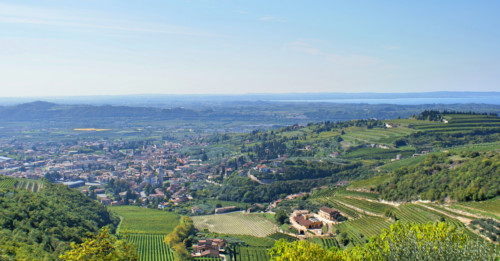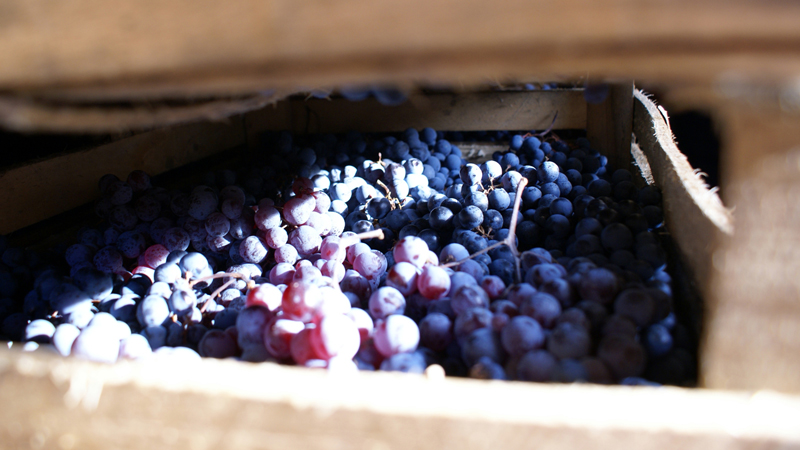It may be best known to Americans as the birthplace of Amarone, but Valpolicella is home to four styles of wine and millennia of viticultural history. From Ancient Greek cellars to contemporary collectible bottles, the red wines of this Italian region might just become your new favorites.
What Is Valpolicella?
Valpolicella is the first Italian appellation by value, second to only Chianti and Montepulciano d’Abruzzo in red wine production. Its name is thought to be a mix of Latin and ancient Greek, and translates to “valley of many cellars.” The region’s revered red wines are diverse, spanning four styles: dry, epic Amarone; the spicy cherry charms of Valpolicella Ripasso; sweet Recioto; and lively, accessible Valpolicella.
Where is Valpolicella?
This 240-square-kilometer area in northern Italy’s Veneto region is located in the foothills of the Alps, which provide its northern border, and in and around the descending valleys of the Lessini Mountains. The region lies on calcareous, limestone- and clay-rich soils, and hills climbing upward of more than 1300 feet above sea level. (The Empire State Building stands 1250 feet tall, not including its spire.) In the plans just south of these mountains, Valpolicella’s vines rest in rich, alluvial soil.
How is Valpolicella made?
The four distinct styles of Valpolicella wine are unusual in that all are made from the same short list of native grapes: Corvina, Rondinella, Corvinone, and Molinara. Rarer still, all four wines are produced throughout the region.
By law Valpolicella DOC wines must be made using 45-95% Corvina. Corvinone can also substitute up to 50% of the quote for Corvina, which brings round, cherry flavors. Rondinella must comprise from 5% up to 30% of the blend, offering lush floral notes. Molinara is used sparingly these days, and provides lean acidity. The resulting Valpolicella wines are bright, lively, and balanced with savory sour cherry flavors.
To make Recioto, winemakers pick ripe grapes from vines and let them dry on mats or hanging from rafters throughout the month of January, then vinifying these shriveled grapes and stopping fermentation before all sugars convert to alcohol. These sweet dessert wines have good acidity and a toothsome mouthfeel.
Amarone, whose name translates to “great bitter,” is made by letting those same dried grapes fully ferment. Amarone is a full-bodied, slightly raisinated wine with a pleasantly bitter finish balanced by hints of dark berries and some cocoa notes. The process came about in the 1930s, as did Ripasso.
Made by fermenting standard Valpolicella with a pomace of grape skins left over from Recioto and Amarone, Ripasso is double-processed, and its name means “re-pass.” These soft, supple, medium-bodied wines combine the sour cherry notes of standard Valpolicella and the soft, bitter, slightly raisined notes of Amarone and Recioto.
When Should I Drink It?
Of the four styles of Valpolicella wines, two have aging power and two are ready to drink in youth. Amarone and Recioto are wines that can last for 10 years or more in the bottle and improve with age (although, let’s be honest, both are also great upon release). As Amarone ages, its pleasant, softly bitter notes and hints of balsamic and cocoa meld into aromas of figs and baker’s chocolate with hints of fresh tobacco. Recioto’s deep toothsome raspberry notes and dried cherry aromas also hang out for a very long time, softening with time.
Standard Valpolicella and Ripasso are best enjoyed within the first five years of their release. Lively, vibrant Valpolicella is redolent of refreshing sour cherry and aromatic herbs, and, like good Beaujolais, benefits from a slight chill. Ripasso is a beautiful dark ruby color with rich spicy aromas featuring a hint of black pepper and calm, sweet cherries.
Why Should I Drink It?
With such a wide range of styles, Valpolicella wines speak to every palate preference. A nice, fresh Valpolicella with some good friends is a great way to start an evening, and a slightly chilled glass of Recioto is the perfect way to finish it off. The welcome pleasant bitter tones of a good Amarone will lift your palate and excite the senses while Ripasso is a great mid-meal companion, or the perfect thing to sip thoughtfully by the fireplace.
What Should I Pair With It?
These dry, versatile reds pair with a variety of dishes and are great company throughout a meal. A juicy steak cooked medium rare with a good Amarone is a match made in heaven. Or go full Venetian with a brasato all’Amarone, a classic dish of braised beef cooked with Amarone and served with polenta. Traditional Venetian fare such as fegato alla Veneziana, sauteed liver with onions and potatoes, or grilled meats match well with Valpolicella Ripasso. Young Valpolicella pairs well with salads and seafood, pastas like gnocchi, beef-filled tortellini di Valeggio, or pizza. Recioto is an absolute success with tiramisu, chocolate, and cakes. Craving something more savory? A plate of local cheeses, blue cheeses, and dried fruits with a glass of Recioto is one of the finer things in life.
What Wines Should I Try?
Cantina Valpantena Verona
Pasqua Vigneti e Cantine
Cantina Valpolicella Negrar
Santi
Sartori di Verona
Massimago
Rocca Sveva


